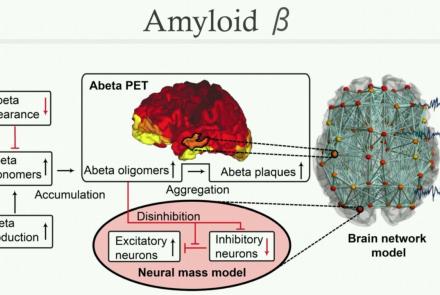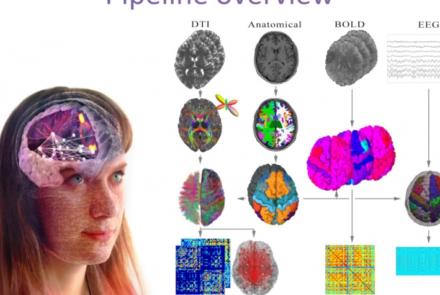Course:
In this lesson you will learn how to simulate seizure events and epilepsy in The Virtual Brain. We will look at the paper On the Nature of Seizure Dynamics, which describes a new local model called the Epileptor, and apply this same model in The Virtual Brain. This is part 1 of 2 in a series explaining how to use the Epileptor. In this part, we focus on setting up the parameters.
Difficulty level: Beginner
Duration: 4:44
Speaker: : Paul Triebkorn
Course:
In this lecture we will focus on a paper called The Virtual Epileptic Patient: Individualized whole-brain models of epilepsy spread. We will have a closer look at the equations of the epileptor model and particular the epileptogenicity index, which controls the excitability of each brain region. Subsequently, we will begin to setup the epileptogenic zone in our own brain network model with TVB.
Difficulty level: Beginner
Duration: 6:25
Speaker: : Paul Triebkorn
Course:
After introducing the local epileptor model in the previous two videos, we will now use it in a large-scale brain simulation. We again focus on the paper The Virtual Epileptic Patient: Individualized whole-brain models of epilepsy spread. Two simulations with different epileptogenicity across the network are visualized to show the difference in seizure spread across the cortex.
Difficulty level: Beginner
Duration: 6:36
Speaker: : Paul Triebkorn
Course:
This lecture gives an overview on the article Individual brain structure and modelling predict seizure propagation, in which 15 subjects with epilepsy were modelled to predict individual epileptogenic zones. With the TVB GUI we will model seizure spread and the effect of lesioning the connectome. The impact of cutting edges in the network on seizure spreading will be visualized.
Difficulty level: Beginner
Duration: 9:39
Speaker: : Paul Triebkorn
This lecture presents the Graphical (GUI) and Command Line (CLI) User Interface of TVB. Alongside with the speakers, explore and interact with all means necessary to generate, manipulate and visualize connectivity and network dynamics.
Difficulty level: Beginner
Duration: 1:02:16
Speaker: : Paula Popa & Mihai Andrei
This lecture briefly introduces The Virtual Brain (TVB), a multi-scale, multi-modal neuroinformatics platform for full brain network simulations using biologically realistic connectivity, as well as its potential neuroscience applications (e.g., epilepsy cases).
Difficulty level: Beginner
Duration: 8:53
Speaker: : Petra Ritter
This lecture introduces the theoretical background and foundations that led to the development of TVB, its architecture, and features of its major software components.
Difficulty level: Beginner
Duration: 46:50
Speaker: : Randy McIntosh
This tutorial demonstrates how to use the image processing pipeline with the HBP collab.
Difficulty level: Beginner
Duration: 5:55
Speaker: : M. Schirner, P. Triebkorn, P. Ritter
This tutorial provides instruction on how to use the TVB-NEST toolbox co-simulation in HBP collab.
Difficulty level: Beginner
Duration: 3:11
In this tutorial, you will learn how to use TVB-NEST toolbox on your local computer.
Difficulty level: Beginner
Duration: 2:16
This tutorial provides instruction on how to perform multi-scale simulation of Alzheimer's disease on The Virtual Brain Simulation Platform.
Difficulty level: Beginner
Duration: 29:08
This presentation accompanies the paper entitled: An automated pipeline for constructing personalized virtual brains from multimodal neuroimaging data (see link below to download publication).
Difficulty level: Beginner
Duration: 4:56
This lesson consists of a supplementary video for the publication: Inferring multi-scale neural mechanisms with brain network modelling.
Difficulty level: Beginner
Duration: 3:06
This lecture provides an overview of successful open-access projects aimed at describing complex neuroscientific models, and makes a case for expanded use of resources in support of reproducibility and validation of models against experimental data.
Difficulty level: Beginner
Duration: 1:00:39
Speaker: : Sharon Crook
This talk highlights a set of platform technologies, software, and data collections that close and shorten the feedback cycle in research.
Difficulty level: Beginner
Duration: 57:52
Speaker: : Satrajit Ghosh
This lecture on model types introduces the advantages of modeling, provide examples of different model types, and explain what modeling is all about.
Difficulty level: Beginner
Duration: 27:48
Speaker: : Gunnar Blohm
This lecture summarizes the concepts introduced in Model Types I and further explains how models can be used answer different scientific questions.
Difficulty level: Beginner
Duration: 32:30
Speaker: : Megan Peters
Course:
This lecture focuses on how to get from a scientific question to a model using concrete examples. We will present a 10-step practical guide on how to succeed in modeling. This lecture contains links to 2 tutorials, lecture/tutorial slides, suggested reading list, and 3 recorded Q&A sessions.
Difficulty level: Beginner
Duration: 29:52
Speaker: : Megan Peters
Course:
This lecture formalizes modeling as a decision process that is constrained by a precise problem statement and specific model goals. We provide real-life examples on how model building is usually less linear than presented in Modeling Practice I.
Difficulty level: Beginner
Duration: 22:51
Speaker: : Gunnar Blohm
Course:
This lecture focuses on the purpose of model fitting, approaches to model fitting, model fitting for linear models, and how to assess the quality and compare model fits. We will present a 10-step practical guide on how to succeed in modeling.
Difficulty level: Beginner
Duration: 26:46
Speaker: : Jan Drugowitsch
Topics
- Artificial Intelligence (5)
- Philosophy of Science (5)
- Provenance (2)
- protein-protein interactions (1)
- Extracellular signaling (1)
- Animal models (3)
- Assembly 2021 (29)
- Brain-hardware interfaces (13)
- Clinical neuroscience (4)
- International Brain Initiative (2)
- Repositories and science gateways (6)
- Resources (6)
- General neuroscience
(14)
- Phenome (1)
- General neuroinformatics
(4)
- (-) Computational neuroscience (90)
- Statistics (2)
- Computer Science (10)
- Genomics (25)
- Data science
(20)
- Open science (37)
- Project management (6)
- Education (2)
- Publishing (1)
- Neuroethics (25)




















